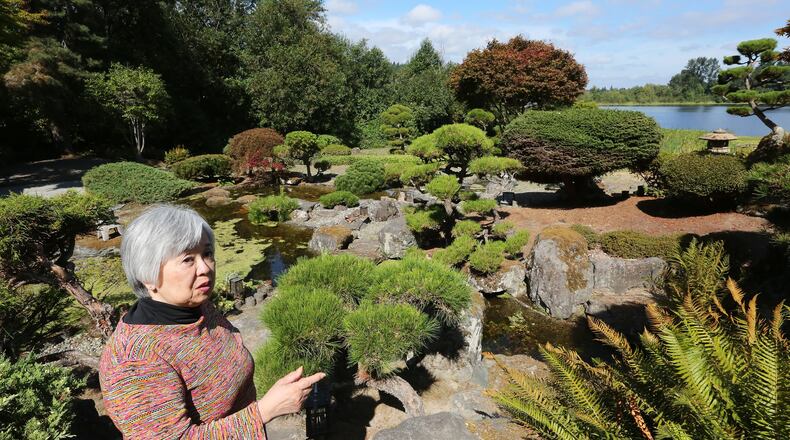Seko Garden, the home and grounds of Joan Seko and her late husband, Roy Seko, could be sold next spring. Joan Seko, 80, can no longer care for the 4-acre property with its hillside Japanese garden sloping down to the lake. She’s purchased a condo about a mile away.
The couple ran Bush Garden restaurant for 44 years, from 1953 to 1997, in Seattle’s Chinatown International District, where it became a center of Japanese-American celebrations, political fundraisers and one of the country’s first, and still beloved, Karaoke bars.
Koichi Kobayashi, a landscape architect who worked on the restoration of the Seattle Japanese Garden at the Washington Park Arboretum in the 1970s, is trying to rally support to find a buyer for the garden who would restore it and open it to the public. He said real-estate agents have told him that the 1950s ranch-style house and garden, valued at about $1.3 million, likely would be leveled and a new lakefront home built on the site.
“I don’t have much time,” Kobayashi said. “I’ve seen a lot of gardens wiped out.”
Little-known legacy, Kobayashi had an office for his landscape-design business in the Chinatown International District, near Bush Garden. He ate there often, he said, and was friends with Roy Seko, but never knew about the Bellevue garden.
He learned about it only five months ago, while he was researching gardens built at Japanese internment camps, including Minidoka, in Idaho, where many Seattle-area families were imprisoned during the war.
Among them were several men who would be influential in Seattle-area landscape design and the construction of local Japanese gardens: Fujitaro Kubota, who built the 20-acre garden that is now a Seattle park and historical landmark; Richard Yamasaki, one of the builders of the Seattle Japanese Garden; and Roy Seko.
Roy’s father, Kaichi Seko, was imprisoned at a different camp, suspected of being a spy because of airplane drawings by his then 14-year-old son. He was released after the rest of the family had returned to Seattle. Once he rejoined them, he founded the Bush Garden Restaurant, bought the Phantom Lake property and hired Yamasaki to help him and Roy Seko build the garden.
The garden features many elements common to a Japanese stroll garden,including a cascading waterfall, three ponds, sculpted and pruned trees, stone lanterns and wandering paths.
Yamasaki installed the rockery and bonsai plants that over the years have become overgrown. Kobayashi said he particularly admires the craftsmanship around the waterfall feature, with its tall, craggy rocks. Roy Seko later installed a pump that circulated lake water that spilled over the rocks and flowed through the descending ponds.
Because of its residential setting, Kobayashi said, it illustrates the variety of Japanese gardens in the Pacific Northwest.
Following Kaichi Seko’s death in 1966, Joan and Roy Seko moved into the Phantom Lake home with Roy’s mother, Suye Seko, where they raised five children and continued to make additions to the grounds, including an arching bridge on the lower pond that Roy built in the family garage. In its prime, the garden was featured in Sunset magazine and The Seattle Times Pacific Magazine.
Joan Seko remembers that in the two weeks before her husband’s death in 2004, she set up a hospital bed in the living room so he could look out over the garden and lake. She said hundreds of people visited to pay their last respects.
But she is not sentimental about the garden. She said she remembers her mother-in-law calling in tears while it was being built. The elder Mrs. Seko said her washing machine was broken and her husband wouldn’t buy her a new one. “He’s paying for rocks,” the mother-in-law said.
Joan Seko also remembers plucking pine needles by hand from the sculpted trees to maintain their form, and rushing out with her husband in the middle of a snowstorm with brooms to keep heavy snow off the trees. all part of the garden’s near constant upkeep.
She pointed to grass now growing in the garden’s gravel walks. “There’s no end to the weeding,” she said.
She appreciates the recognition the garden is now getting, and would like to see it saved but said she can’t wait around for a grand plan that may never materialize.
“I’m old. I can’t keep it up. My kids won’t let me get up on a ladder anymore.”
HOPEFUL VISION
Kobayashi estimates it would cost between $5 million and $10 million to purchase the property and restore and improve the garden. That cost also reflects his ultimate vision — to have a traditional Japanese residence designed and built on the property to replace the existing house.
“The goal is to make the property so unique and precious that no one would want to destroy it,” he said.
Kobayashi said that in the garden he can see the hand of the three men who designed and built it, Yamasaki, Kaichi Seko and Roy Seko, and in that collaboration, their pride in their Japanese heritage and their ability to create landscapes of beauty and tranquility after an experience that he called “the most bitter of their lives.”The garden, he said, is “a piece of art and a piece of history. It would be sad for all of us to lose it.”
About the Author
